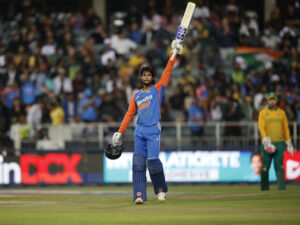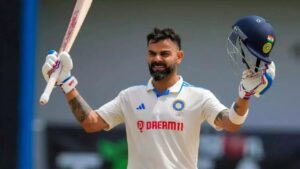
Controversy Surrounds Captains to Lead India After MS Dhoni’s Test Retirement: A Battle of Leadership Styles and Strategy
The retirement of MS Dhoni from Test cricket in December 2014 left a gaping hole in Indian cricket, not just in terms of his performance behind the stumps, but his leadership on the field. Dhoni was not just a captain; he was a talismanic leader who guided India to unprecedented success in all formats. His departure thrust India into a search for new leadership, sparking debates that continue to divide the cricketing community. The captains who succeeded him, particularly Virat Kohli and Ajinkya Rahane, brought contrasting styles to the forefront, leading to a heated discourse on what type of leadership best suits Indian cricket.
Virat Kohli: Aggression Over Pragmatism?
Virat Kohli’s appointment as the full-time Test captain in early 2015 marked a seismic shift in India’s leadership dynamic. Kohli, known for his fiery temperament and aggressive demeanor, took Indian cricket to new heights, particularly in terms of fitness standards and overseas success. His mantra of playing five bowlers, adopting an attacking mindset, and chasing victories even in challenging conditions, made him a beloved figure for many fans.
However, Kohli’s captaincy has not been without its critics. Some argue that his aggression often came at the expense of strategy. His decision-making in crunch moments has been questioned, particularly his reluctance to persist with proven performers like Ajinkya Rahane or Ravi Ashwin in certain series. Kohli’s failure to clinch key Test series victories in England and New Zealand, despite having one of India’s most balanced squads ever, has raised doubts about his tactical acumen.
There’s also the issue of Kohli’s dominance over team selection. Some critics suggest that Kohli’s aggressive nature led to impulsive selections and dropping players after just one bad game, creating an atmosphere of uncertainty in the dressing room. His captaincy tenure was littered with instances where talent like Kuldeep Yadav and Karun Nair were cast aside, raising questions about the fairness of his leadership.
Kohli loyalists, however, point to his unparalleled record at home, his role in making India a top Test side, and his fitness revolution. But the argument persists: Did Kohli’s aggression, while pushing Indian cricket to new heights, overlook the nuance and flexibility needed for sustained success in the longest format?
Ajinkya Rahane: The Calm Leader India Never Valued?
If Kohli embodied aggression, Ajinkya Rahane was the epitome of calmness. Rahane stepped into the captaincy role during Kohli’s absence and led India to arguably one of their most historic Test series victories—down under in Australia in 2020-21. Despite being depleted by injuries and without their superstar Kohli, Rahane marshaled a battered team to a miraculous 2-1 series win, including that famous chase at the Gabba. Rahane’s tactical nous, understated leadership, and ability to bring the best out of the team in adversity were on full display.
But why was Rahane never given a longer rope as captain? Critics of Indian cricket’s decision-making suggest that the BCCI and selectors were reluctant to embrace Rahane’s quieter leadership style. In an age where charisma and marketability often trump substance, Rahane’s reserved persona perhaps didn’t align with the board’s vision of a bold, headline-grabbing captain. His personal form also dipped after his stint as captain, which conveniently gave the selectors an excuse to ignore his leadership potential.
Rahane’s supporters argue that Indian cricket lost a golden opportunity by not fully embracing him as a long-term Test captain. His calmness, particularly in overseas conditions where temperament is key, was seen as an asset. Some even believe that Rahane could have been a better fit than Kohli for leading India in high-pressure overseas series, where Kohli’s hyper-aggression sometimes backfired. It remains a point of contention whether Rahane’s demotion after his leadership heroics in Australia was justified or simply a reflection of Indian cricket’s obsession with glamour and personality over quiet competence.
The Unfulfilled Potential of Rohit Sharma
While Rohit Sharma has taken over the reins of the Indian Test team more recently, his Test captaincy journey could have begun much earlier. Often sidelined as a white-ball specialist, Rohit’s transformation as a Test opener and his astute captaincy in limited-overs cricket made many wonder why he wasn’t considered a legitimate contender to lead the Test side after Dhoni’s retirement.
Rohit’s captaincy style is an intriguing blend of Kohli’s aggression and Rahane’s calm. He’s a master tactician, capable of making sharp decisions under pressure, and has shown that he can handle big moments, as seen in his IPL successes. Critics believe that India may have lost years of Test success under his captaincy had he been given the opportunity earlier.
However, Rohit’s longevity in the Test arena has always been questioned due to his fitness and injury issues. These concerns may have played a role in the selectors hesitating to appoint him after Dhoni’s exit. Still, his appointment in 2021 has shown promise, but one wonders what Indian cricket could have looked like if Rohit had been in charge earlier. Could he have delivered where Kohli failed?
The Captaincy Debate: A Reflection of Indian Cricket’s Conflicted Identity
The post-Dhoni captaincy saga highlights a deeper conflict within Indian cricket—a clash between the old-school traditionalists who value calmness and consistency, and the new-age fans and administrators who crave aggression and flair. Kohli’s tenure, while successful, saw the team drift towards a more individualistic, star-driven culture, where loyalty to the system often took a backseat to personal charisma. Rahane’s temporary success, and his subsequent sidelining, underlined how undervalued calm leadership can be in a world that celebrates fiery ambition.
In retrospect, Dhoni’s ability to combine calmness with ruthlessness made him an irreplaceable leader. Kohli, Rahane, and now Rohit Sharma, each brought their own strengths to the table, but none have quite managed to replicate the balance that Dhoni maintained. This ongoing debate over who should have led India after Dhoni is not just about leadership styles but is emblematic of a larger question—what kind of cricketing identity does India want to embrace?
As we reflect on the captains who followed in Dhoni’s footsteps, it becomes clear that the question of leadership in Indian cricket will always be fraught with controversy. Kohli’s aggression, Rahane’s calm, and Rohit’s tactical acumen each had their merits, but the debate remains—who was truly the right choice to carry forward Dhoni’s legacy? And more importantly, did Indian cricket make the right calls at the right time, or did they miss the opportunity to embrace a leadership style better suited to their long-term success?






